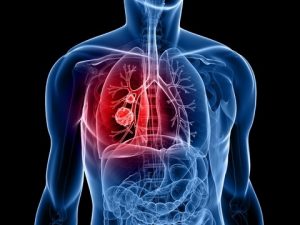Cigarette smoking markedly increases the risk of developing lung cancer. Historically, that risk has been gauged by how much and how long a person smokes, often described in pack-a-day terms over a period of years. However, data from several large population-based studies suggest that a person’s ethnicity and race influence risk. Findings from a recent review suggest that biomarkers of tobacco exposure may be better determinants of risk, reconciling these two disparate views.

Biomarkers are easily measured indicators of a person’s exposure to certain chemicals. After the chemicals are metabolized, or broken down, in the body, their byproducts, called metabolites, can be measured in the blood, urine, or saliva. Tobacco smoke from cigarettes contains thousands of chemicals, many of which cause cancer. Their metabolites show up in a smoker’s urine and reflect exposure.
A biomarker called total nicotine equivalents, or TNEs – a measure that includes nicotine and the majority of its metabolites – can be used to gauge smoking exposure. “People metabolize nicotine differently,” says Sharon E. Murphy, Ph.D., a professor of biochemistry, molecular biology, and biophysics at the University of Minnesota Masonic Cancer Center and the lead author of the review. “By measuring TNEs, we get a better measure of exposure than you get with cigarettes per day.”
The reviewers summarized the findings of studies involving cigarette smokers participating in the Multiethnic Cohort Study, a large ongoing study conducted at the University of Hawaii Cancer Center and the Keck School of Medicine at the University of Southern California. Participants include more than 215,000 men and women of African American, Japanese, Latino, Native Hawaiian, and Caucasian origin. The Multiethnic Cohort Study is one of the most ethnically diverse epidemiological studies to date.
A key finding from the review suggests that the activity of a key enzyme involved in metabolizing the chemicals in cigarette smoke – called CYP2A6 – varies among ethnic and racial groups. This difference in metabolism is because some people carry variants of the gene that makes CYP2A6, altering its activity. Others don’t carry the gene at all. Japanese Americans have the lowest CYP2A6 metabolism compared to the other groups. Low CYP2A6 metabolism is linked with lower TNE exposure and lower risk of developing lung cancer.
The other important finding was that lung cancer risk varied among ethnic and racial groups, even if the number of cigarettes smoked was the same. Japanese Americans and Latinos have the lowest risk of developing lung cancer, while African Americans and Native Hawaiians have the highest risk. Whites have an intermediate level of risk compared to the other groups.
The way the smokers metabolized the chemicals in the cigarettes was a key factor. “One of the major contributors to the risk difference across these groups is the difference in the amount of exposure to the carcinogens per cigarette,” says Murphy. The risk difference closely paralleled the incidence of lung cancer – with the exception of native Hawaiians – observed in a previous study conducted a decade ago, she added.
One of the strengths of this review is the unique study population, says Murphy. “The cohort is ethnically diverse, but all the participants live in the United States, so they share common environmental exposures.” Whereas these findings suggest that metabolic differences among racial and ethnic groups influence lung cancer risk, Murphy and her fellow reviewers concede that other factors play roles in racial and ethnic differences, including how epigenetic changes, inflammation, and other disease-related factors differ between groups.
This review provides a stepping off point for future research that investigates smoking biomarkers in a prospective study and further investigates links between CYP2A6 activity and risk.
Learn more about biomarkers and reducing lung cancer risk from AICR.





